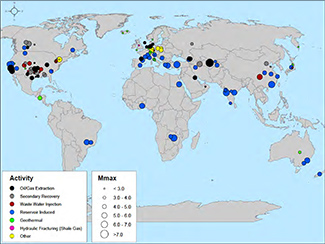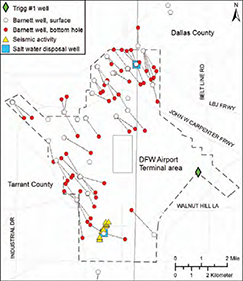Nine months after a National Academy of Sciences panel said oil and gas regulators should take steps to prevent man-made earthquakes, officials in key states are ignoring quake potential as they rewrite their drilling rules.
Two major drilling states, California and Texas, are overhauling their drilling rules without looking at the seismic risks linked to deep injection of drilling and hydraulic fracturing wastewater. New York regulators dismissed earthquake concerns in their drawn-out process of updating drilling rules.
One possible exception, though, may be Illinois. Comprehensive legislation introduced there mirrors the "traffic light" regulation system suggested in the NAS report. That system would allow small earthquakes but would shut down wells when public safety is at risk.

Locations of earthquakes linked by scientists to human activity. Click the map for a larger version. Map courtesy of the National Research Council.
The NAS panel, chaired by Colorado School of Mines professor Murray Hitzman, said earthquakes associated with drilling can pose a risk to public health and safety.
"The regulatory body affiliated with the permitting of wells should include, as part of each project's operation permit, a mechanism (such as a 'traffic light' mechanism) for the well operator to be able to control, reduce, or eliminate the potential for felt seismic events," the panel wrote in its report (Greenwire, June 15, 2012).
U.S. EPA has also looked at earthquakes related to energy development. But its study has stalled in the draft stage, and EPA officials say they have no timetable for issuing a final report (EnergyWire, March 19, 2013).
Geologists have known for decades that deep injection of industrial waste can lubricate faults and unleash earthquakes. One of the most famous instances of man-made earthquakes, or "induced seismicity," occurred in the late 1960s at the Rocky Mountain Arsenal near Denver, where the Army manufactured chemical weapons.
Some earthquake researchers now say the nation's drilling boom, fueled by advances in high-volume hydraulic fracturing, could be spurring a rash of such man-made quakes.
Most seismologists agree that the specific process of hydraulic fracturing presents little or no risk of triggering earthquakes that damage property or injure people. [Except for the magnitude 5.6 in Oklahoma in 2011 maybe?]
But injection wells are a different story. Fracking and production of shale gas produce millions of gallons of wastewater far saltier than seawater and laced with toxic and even radioactive chemicals. Some can be reused, but eventually, what comes to the surface must be disposed of. Usually, that's into injection wells.
Very few of the 40,000 brine disposal wells in the country have been linked to seismic ruptures. But in the shale drilling boom of the last few years, earthquakes have been linked to injection wells in Arkansas, Colorado, Ohio, West Virginia, Oklahoma and Texas.
The "traffic light" protocol recommended by the NAS panel suggested a gradual approach to injection wells for regulators, which are usually state oil and gas agencies.
At first, they could require operators to scale back how much fluid they're injecting if a well gets linked to seismicity. But if the earthquakes were to continue and threaten serious damage or injury, wells would be shut down under such a protocol.
The panel's report, done for NAS's National Research Council, also said regulators should evaluate the possibility of an earthquake at potential injection sites. That is not done for wells that receive oil and gas waste in most states.
State breakdowns
Texas has had some of the best-documented seismic activity around brine wells. Researchers have linked injection to earthquakes in the Haynesville Shale in east Texas and the Barnett Shale in the Dallas area (EnergyWire, Aug. 7, 2012). Chesapeake Energy Corp. shut down two wells linked to quakes near the Dallas/Fort Worth Airport.
The Texas Railroad Commission, which regulates oil and gas production, is doing a large-scale revision of its rules without looking at man-made earthquakes.

A map from a study by University of Texas research scientist Cliff Frohlich shows the proximity of injection wells, or salt water disposal wells, to earthquakes near the Dallas-Fort Worth Airport in 2009. Click the map for a larger version. Map courtesy of the National Research Council.
"The geology of states vary greatly, and Texas has a long history of safe injection," said Gaye McElwain, spokeswoman for the Texas Railroad Commission, which oversees oil and gas, not trains. "Our staff also are closely following various studies that are being conducted to determine possible man-made causes of recent seismic events."
California is not known to have had earthquakes linked to fracturing or deep injection. But it has more experience with damaging and lethal earthquakes than other states.
And oil and gas companies are just beginning to develop the Monterey Shale in Southern California, which could spit up millions of gallons of water to be injected underground.
California's Division of Oil, Gas and Geothermal Resources (DOGGR) is revising its underground injection rules in the wake of criticism from U.S. EPA that they are insufficient to protect groundwater and examine the effect of wells in too narrow of an area (EnergyWire, Nov. 21, 2012).
California officials say they don't see the need to look at injection wells and earthquakes, saying existing rules are sufficient.
"While seismicity is not specifically mentioned in the California Code of Regulations, DOGGR believes it is adequately addressed," said agency spokesman Don Drysdale.
"Operators must evaluate oil and gas reservoirs prior to injection, and that evaluation includes faulting."
"Operators must evaluate oil and gas reservoirs prior to injection, and that evaluation includes faulting."
Donald Clarke, the geologist who served as vice chairman of the NAS panel, said the state has been giving close scrutiny to injection wells in recent years.
"It's tightened up a lot," Clarke said. "The sad part is, they're understaffed to be doing all this."
Stanford University geophysics professor Mark Zoback, who authored a widely cited article on the traffic light protocol last year, also said California's existing safeguards seem adequate.
"If they're requiring operators to evaluate for faulting, then they are addressing the issue," Zoback said.
New York's regulators have been mixed on the dangers of drilling-related quakes. In drafting regulations that would open upstate New York to drilling and hydraulic fracturing, officials at the Department of Environmental Conservation dismissed the possibility of earthquakes, saying there is "essentially no increased risk to the public."
Ohio shut down an injection well in 2012 and rushed to implement emergency seismic rules for injection after a well was linked to repeated earthquakes in Youngstown. The beefed-up rules allow state officials to order seismicity tests before a well is drilled and specify the volume and pressure of fluids injected. Once the well is operating, the Division of Oil and Gas Resources Management can monitor it and force it to shut off.
Ohio's concerns didn't spread, though some states have taken smaller steps. An example is Colorado, where oil and gas officials are requiring a review by the state geological survey before granting new injection permits.
Other states are still waiting. Oklahoma oil and gas official have allowed drilling companies to inject their wastewater next to an active fault that ruptured in 2011, causing a magnitude-5.6 earthquake (EnergyWire, July 25, 2012).







No comments:
Post a Comment